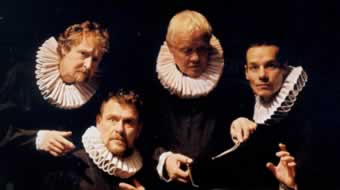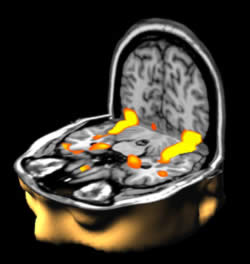This year the Cheltenham Festival of Science, which is now in its second year, attracted more than 20,000 visitors. During the meeting, I went to a presentation that proclaimed it would reveal 'the best ideas in science ever'.
The event was staged as a debate between Peter Atkins, Professor of Chemistry at the University of Oxford, and Peter Tallack, a former editor at Nature and editor of 'The Science Book'. Atkins' choices were evolution by natural selection, the expanding universe, and the second law of thermodynamics (Atkins, 2003), whereas Tallack plumped for the scientific method, the atomic hypothesis, and the equivalence of the mind and the brain (Tallack, 2001). Tallack claimed that, of all these ideas, the one that trumped them all was the scientific method: the idea that there is an objective world out there that can be probed by experimental investigation. None of the others, he claimed, would have been verifiable without it. I too believe that the scientific method is the best of the lot, but unfortunately the audience gave that accolade to natural selection. Although I'm sure the lay public had a good grasp of the importance of the scientific method, I'm sure natural selection came out on top because there are more popular science books on evolution than on any other topic - quite apart from the fact that Darwin holds a special place in the hearts and minds of the British public.
During the question time I suggested that none of the ideas that had been presented were truly great ideas, and that the importance of understanding our scientific limitations, rather than simply extolling the virtues of the scientific approach, is the greatest notion in science today. It is this belief that I want to expand upon.
 |
| Figure 1: All highlighted areas (coloured) are based on regions of activation found in functional magnetic resonance imaging (fMRI) studies while volunteers viewed pictures of their partners. |
Some time ago I took a friend, who was having a few problems with his relationship, to a lecture titled 'The neural basis of romantic love' professing that he would find love in science even if he couldn't find it at home (Bartels, 2002). Towards the end of the lecture, the areas where 'love' was to be found in the brain were revealed (Figure 1- right). I stood up to ask the speaker 'now that you have investigated and found love in the brain, how has this personally informed you of what love is?' Of course, science hadn't helped, nor could it help, nor will science ever help to answer such questions. It was the wrong tools for the job.
The limitations of language have always been too apparent to me. As a child I was lucky enough to suffer from synaesthesia - I was able to taste shapes. Even though the scientific method can describe in detail why this happens, I can never explain to you the taste of the sharp pointed corners of a cube or a right-angled triangle, nor the taste of flatness of a solid plane as it melts on the end of my tongue. Clearly Nietzsche was on the right lines when he suggested that science describes the world in wondrous detail and complexity, yet disappointingly without ever really explaining anything.
In 1982 Jackson argued in a analogous fashion, that a neuroscientist with black-and-white vision might know all the physical facts about colour vision, but would still not know what it is like to experience seeing red (Jackson, 1982). Similarly, science can describe the various functions of the brain associated with emotions such as fear or love, yet we are no closer to sharing them.
Over the last few decades, investigation into consciousness has finally been deemed worthy by the scientific community. Although artists might claim to have been manipulating our phenomenological experience of the world - via our central nervous system - through artistic stimuli, which thrill, question and captivate, for many hundreds of years. Richard Gregory in trying to unravel consciousness proposes that the '�difference between hypothesis of science and the perceptual hypothesis is that only perceptions have consciousness - qualia - such as sensations of red, sound or pain' (Gregory, 1998). These vivid sensations, which are second nature to the artist, may be stimulated by qualia-like visual and emotional components of art, drama, music or literature. The shared universal experience of living and dying is embodied in Bill Viola's Nantes Triptych (Figure 2), which couples the shadowy bay between birth and death (Viola, 1992). Here we can experience the immediacy of a full-lived experience, it is here we can communicate the phenomenological experience of our world, it is in this arena that we open a platform into consciousness, not through the understanding of microtubules as Roger Penrose offers (Penrose, 1998).
 | Figure 3 : Mapping Perception (2002) film and installation, (Dirs Andrew Kotting and Mark Lythgoe). Mapping Perception examines the limits of human perception through an investigation of impaired brain function, making visible the connections between scientific and artistic explorations of the human condition, probing the thin membrane between the able and the disabled. |
Working with artists and scientists for the last 10 years (Lythgoe 2002, 2002a, 2000b) has demonstrated to me that great art constitutes an open investigation into the human condition: into experience, memory and love - subjects that are also common to scientific study. And that scientists and artists can collaborate with different aims and objectives, while pursuing similar kinds of questions (Figure 3 - above).
 | Figure 4 (left) : When you recognize a familiar face the parts of the brain highlighted in orange on this functional magnetic resonance image (fMRI) light up. In this case 'lighting up' means there is increased blood flow to the areas that are working hardest. Functional MRI allows these regions to be visualized. Winning image from the Wellcome Trust Biomedical Image Award in 2003 (image courtesy Mark Lythgoe and Chloe Hutton). |
Figure 5 (right). Portrait of a Molecular Biologist (2003). We understand much about DNA and how it builds a human, but we still have much to rejoice in humanity itself. This portrait of a molecular biologist celebrates both the discovery of DNA and our individuality. We are, indeed, greater than the sum of our parts (� Dr Charmaine Griffiths, The British Heart Foundation). |  |
Today our understanding of the brain is being transformed by many new developments in science, not least the emergence of imaging technologies, including magnetic resonance imaging (MRI). These technologies enable us to visualise the various structures of the brain in remarkably fine detail, and to see which structures are activated by particular tasks, such as moving the fingers or listing words beginning with 'c', or even just thinking about doing these things. MRI is also extensively used in neuroscience research, highlighting which parts of the brain are activated when one feels elated, or angry, or scared, or whatever (Figure 4 - above). But can the scientific method really explain what love or hatred is, even if it tells us which parts of the brain are associated with these emotions? Can it really tell us what consciousness is? To look fully inside the brain, to really know what someone is feeling, maybe we need something more than science can offer, and maybe combining science and art goes some way towards providing that something more (Figure 5 - above).
ACKNOWLEDGEMENTS: The authors would like to thanks Marion Kalmus (artist-in-residence in the RCS Unit of Biophysics, Institute of Child Health, UCL, London, and Rachael Dobson for their helpful comments and suggestions.
- Previous Natural Remedies
- Next Why what you see is NOT what you get !










Comments
Add a comment